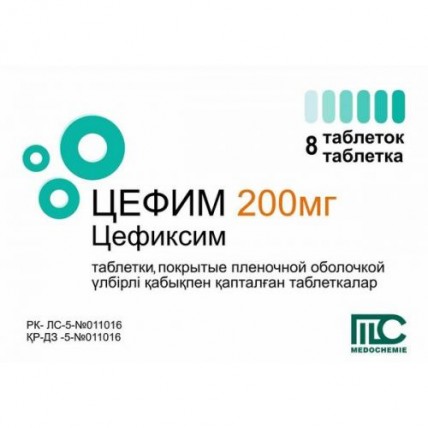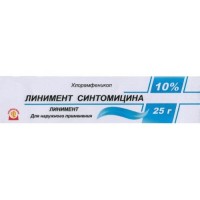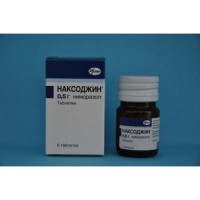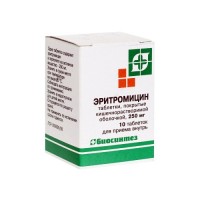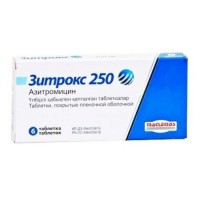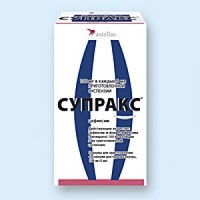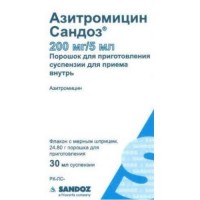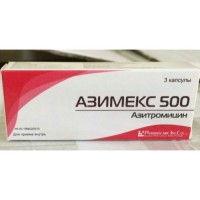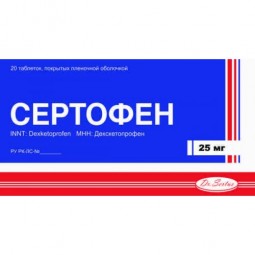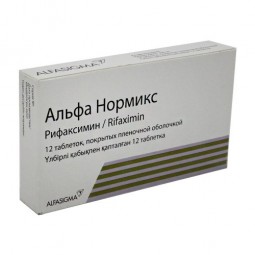Tsefim 8's 200 mg film-coated tablets
- $20.70
The instruction for medical use of Tsefim Torgovoye medicine a name Tsefim the International unlicensed name Tsefiksim Lekarstvennaya the Tablet form, film coated, 200 mg Structure One tablet contains active agent - a tsefiksim trihydrate of 223.84 mg (it is equivalent to a tsefiksim of 200.00 mg) excipients: lactoses monohydrate, cellulose microcrystalline, sodium of a kroskarmelloz, silicon dioxide colloidal anhydrous, magnesium stearate. Structure of a film cover of Opadri white OY-B-28920: polyvinyl alcohol, the titan dioxide (E171), talc purified, lecithin, gum xanthane (E 415). The description of the Tablet of a capsulovidny form, with a biconvex surface, film coated white color, with risky on one party. Pharmacotherapeutic group Beta laktamnye antibacterial drugs other. Cephalosporins of the third generation. Tsefiksim. The ATX JO1 DD08 code the Pharmacological Pharmacokinetics Later properties of intake is slowly soaked up by tsefiksy, with achievement of the maximum level in blood serum in 2 – 6 hours after reception. At reception of a single dose of 200 mg or 400 mg the concentration of drug in blood serum reaches 1-4мг ml or 1.9-7.7мг ml, respectively. The bioavailability is 40% - 50%, meal does not influence drug absorption. Tsefiksim for 50% - 65% contacts proteins of blood plasma, with a capacity of distribution of 0.6 – 1.1l/kg. Badly gets through a blood-brain barrier, gets through a placenta, it is allocated with breast milk. About 50% of a dose are removed with urine, 5% are removed with bile. Eliminative elimination half-life makes 3 - 4 hours, this period increases till 6 o'clock in case of a moderate renal failure and, approximately, till 11 o'clock in case of a serious renal failure. The pharmacodynamics the Tsefalosporinovy antibiotic of the third generation of a broad spectrum of activity, works bakteritsidno. Affects aerobic and anaerobic pathogenic flora, both gram-positive, and gram-negative. Bactericidal action of a tsefiksim is based on inhibition of synthesis of a cell wall of bacteria. Tsefim is highly resistant to action beta laktamaz. It is active concerning the following microorganisms: Streptococcus pneumoniae, Streptococcus pyogenes, Escherichia coli, Salmonella spp., Shigella spp., Proteus mirabilis, Klebsiella species, Haemophilus influenzae, Branhamella catarrhalis, Enterobacter species, Nesseria gonorrheae. Are resistant to a tsefiksim: Bacteroides fragilis, Listeria monocytogenes, Clostridia, Enterobacter. Indications Tsefim are appointed for treatment of the diseases caused by microorganisms, sensitive to drug: - an infection of ENT organs (sinusitis, pharyngitis, tonsillitis, average otitis) - lower respiratory tract infections (acute and chronic bronchitis, pneumonia) - infections of urinary tract (pyelonephritis, cystitis, an urethritis, a salpingitis, an oophoritis, an endometritis, a vaginitis, septic abortion, gonorrhea) - postoperative infections the Route of administration and doses For intake. A pill is taken after a meal. The course of treatment makes 7 days. In case of the serious or badly responding to treatment infections, a course of treatment up to 14 days. Children are from six to ten years old, weighing 30-50 kg - 200 mg daily. For children weighing less than 30 kg - 3-9 mg/kg a day. The highest dose makes 12mg/kg, the average dose makes 8mg/kg. To adults and children is more senior than ten years: The recommended dose for treatment of the majority of infections makes 200 mg or 400 mg a day, depending on disease severity, divided into 2 receptions. Frequency rate of reception by the adult – 2 times, to children 2-3 times a day. Uncomplicated cervical or urethral gonorrhea the Recommended daily dose makes 400 mg or 800 mg. The liver failure In a liver failure is not required dose adjustment. The renal failure At clearance of creatinine more 20ml/minute - is appointed a usual dosage and an interval between receptions. Clearance of creatinine less 20ml/minute: it is not necessary to exceed the dose of 200 mg accepted once a day. The average duration of a course of treatment is 7-10 days. Side effects Often (from ≥1/100 to & lt, 1/10) - diarrhea not often (from ≥1/1,000 to & lt, 1/100) - a headache - an abdominal pain, digestion disturbance, nausea, vomiting, constipations - an erythema, rash - reversible increase in liver enzymes (transaminases, alkaline phosphatase) in blood plasma is rare (from ≥1/10,000 to & lt, 1/1,000) - dizziness, sonitus - loss of appetite and a meteorism - an eosinophilia, increase in urea in blood serum - an itching and inflammation mucous - superinfection steady bacteria or mushrooms (at prolonged or repeated use) - reactions of hypersensitivity of varying severity, an acute anaphylaxis, medicinal fever Very seldom (& lt, 1/10,000) - a leukopenia, an agranulocytosis, a pancytopenia or thrombocytopenia, fibrillation disturbances, increase in creatinine in blood serum, a hyperbilirubinemia - tranzitorny hyperactivity, is possible development of spasms - the antibiotiko-associated inflammation of a large intestine (for example, pseudomembranous colitis, dysbacteriosis) - a multiformny erythema, a Lyell's disease, syvorotochno-similar reactions, Stephens-Johnson's syndrome, a Quincke's edema, a face edema, a toxic epidermal necrolysis - hemolytic anemia, aplastic anemia - interstitial nephrite, a renal failure - hepatitis, cholestatic jaundice - genital candidiasis, a genital itching, a vaginitis - hypovitaminosis In - the Contraindication asthma - hypersensitivity to antibacterial drugs of group of cephalosporins or any component of drug - presence of bleedings in the anamnesis - pregnancy and the period of a lactation - children's age up to 6 years - hereditary intolerance of fructose or malabsorption of glucose galactose - the serious illness of digestive tract which is followed by vomiting and diarrhea Medicinal interactions the Concomitant use of Tsefim and aminoglycosides can cause nephrotoxicity. One-stage reception of Tsefim and anticoagulants strengthens action of the last, reduces the prothrombin ratio. Live tifoidny vaccine has to be applied, at least, in 24 hours after reception of the last dose of Tsefim as Tsefim has antimicrobial effect on Salmonella typhi. The antiacid drugs containing magnesium or aluminum hydroxide slow down absorption of a tsefiksim. Special instructions Patients with a renal failure should appoint drug with care, at clearance of creatinine & lt, 20 ml/min. are necessary reduction of a dose of drug (see the section Route of Administration and Doses). Due to the possibility of cross allergic reactions with penicillin, it is recommended to estimate the anamnesis of patients carefully. At emergence of allergic reaction the use of drug has to be immediately stopped. At long administration of drug the disturbance of normal intestinal microflora is possible that can lead to excess reproduction of Clostridium difficile and development of pseudomembranous colitis. At emergence of easy forms the antibiotic - the associated diarrhea, as a rule, is enough to stop administration of drug. During treatment the positive reaction of Koombs and false positive reaction of urine to glucose are possible. Features of influence of drug on ability to run the vehicle or potentially dangerous mechanisms Considering side effects of drug, it is necessary to be careful during the driving of the car and occupations other potentially dangerous types of activity requiring special attention and speed of psychomotor reactions. The overdose is not available messages about overdose cases. Treatment has to be symptomatic and supporting the vital functions of an organism. Gastric lavage can be effective means. Dialysis is a little effective. Special antidote does not exist. The form of release and packing On 4 tablets place in blister strip packaging from a film of polyvinylchloride and aluminum foil. On 2 planimetric packs together with the instruction for medical use in the state and Russian languages put in a pack from cardboard. To Store storage conditions in the dry, protected from light place at a temperature not above 25ºС. To store in places inaccessible for children! A period of storage 3 years not to use drug after expiry date. Medokemi Ltd Producer, CYPRUS 51409 of CY-3505 Limassol tel.357-25-867600, fax.357-25-560863, the Address of the organization of the claim accepting in the territory of the Republic of Kazakhstan for quality of products (goods) from consumers Representative office of Medokemi LTD in Republic of Kazakhstan 050008 Almaty, Mukanov St. 241, office 1 of B
to Develop prescription status According to the prescription
to Develop prescription status According to the prescription
